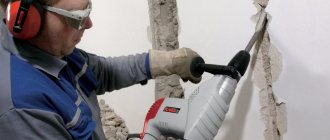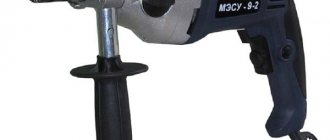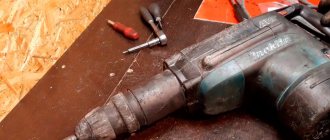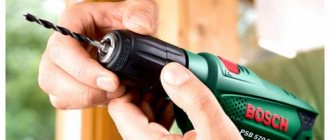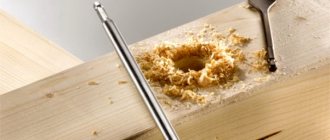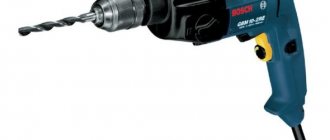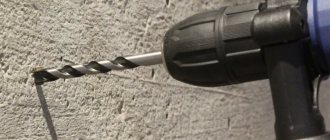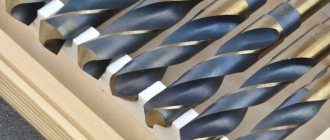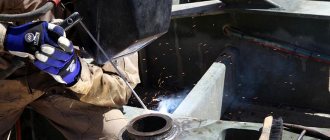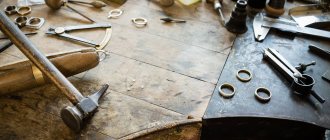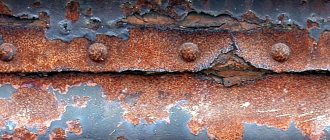The stuck fragment of the drill is removed with wire cutters, pliers, tweezers, if its tip can be caught. Knocked out with a hammer or other tool. Often the fragment gets stuck tightly, and it can only be removed by using more effective measures. When choosing the optimal extraction method, you should take into account the diameter of the fragment and the dimensions of the part where it is embedded. As well as the type of metal in which the fragment is stuck and how deep.
Reasons for failure of metal drills
Photo #1: broken drill
The following reasons lead to drill breakage.
- Drilling with tools made from less hard materials. For this reason, drills break most often.
- Failure to comply with cutting conditions. When drilling at powers exceeding the recommended ones, overheating and overloads occur.
- Wear of cutting edges. It is caused by prolonged use of the tool without sharpening, excessive load and other factors.
- Failure to comply with the cooling mode. Breakdowns are caused by using a small amount of coolant or its incorrect composition. Overheating occurs.
In addition, problems can arise due to incorrect selection of drill diameter.
Using Spring Wire
The diameter of the drill is smaller than the hole where it is stuck, so you can use a spring wire to remove it. This method is suitable if the piece sticks out and you can get to it.
How to apply spring wire:
- Heat the stuck fragment.
- Use a cutter to make grooves on opposite sides of the fragment.
- Place the spring wire in the spiral groove of the broken drill (it should fit completely into it) and solder it.
- Try to twist the stuck fragment until it turns.
- Remove quickly.
What factors influence the choice of method for removing a stuck drill?
The following factors influence the choice of method for removing a stuck broken drill.
- Type of failure (whether the fragment protrudes outward or is stuck deep).
- Dimensions of the part/workpiece.
- The material from which it is made.
- Diameter of stuck drill.
Photo #2: Drill stuck inside the workpiece
conclusions
- It is advisable to pull out a piece of a drill embedded in the metal using a spring wire or a bolt with welded spokes, if the diameter of the fragment is 8 mm or more, and its tip sticks out and you can grab onto it.
- A fragment with a diameter of less than 8 mm, embedded in a small object (can be placed in a container), is recommended to be removed using citric acid.
- You can remove a fragment from an aluminum product using an electrolyte - nitric acid.
- You can drill out a piece of a drill if the workpiece in which it is stuck does not have a complex mechanism inside and is not of particular value.
How to remove a broken drill from metal
You can remove a broken drill from metal in various ways. First, let's look at the simplest situations.
- Part of the drill bit sticks out. In this case, lubricate the hole from the inside using a syringe. To remove the broken drill bit from the metal, use pliers or pliers.
- The piece was stuck inside. In this case, proceed like this.
Take a suitable drill of the same diameter.
- Drill a hole with it on the other side (at the same point) to the stuck piece.
- Knock it out with a rod or tool of suitable diameter (it is advisable to use a backing).
Note! The second method is relevant only if the opposite side of the workpiece can be accessed and a through hole needs to be made in it.
Let's consider special methods for removing drill fragments stuck inside the workpieces.
Extraction using a bolt with spokes welded to it
A slightly protruding piece of drill with a diameter of 8 mm or more can be pulled out using a bolt and knitting needles welded to it. What you will need:
- Pour a substance into the hole that will reduce friction, for example, mixed with kerosene or regular motor oil, or any lubricant.
- Place the knitting needles in the grooves of the broken drill.
- Remove the fragment by turning it out, turning the bolt from right to left.
Use of citric acid
This method is suitable for removing small diameter drill bits from small parts.
- Take a container made of stainless steel.
- Prepare an aqueous solution (20 g of citric acid per 100 g of water).
- Lower the part into the mixture with the hole facing down.
- Place the container on an adjustable heating device.
- Set the temperature to 90 °C.
Removing the drill bit using this method will take several hours.
Removing drill bits using strong electrolytes
This method of pulling out the drill is suitable if the workpiece is made of aluminum. An aqueous solution of nitric acid is used.
Before using this method, you must lubricate the area near the broken drill with wax or paraffin. After this, apply a solution of nitric acid to the fragment, wait until the composition corrodes the cutting edges, and then knock out the stuck piece of the drill using a tool bit.
Note! The ambient temperature must be at least 20 °C.
Drilling
To drill out a broken drill bit, use a tool made of a harder material. This method, which requires patience, caution and care, is rarely used for two reasons.
- Drilling out a fragment can lead to deformation of the workpiece and the formation of a bend. In this case, the stuck piece of the drill will penetrate even deeper into the body of the part and at an angle.
- When working with equipment, there is a possibility of chips getting into important components and mechanisms.
If you don’t mind the part, drill a hole of a larger diameter in this place, and then pick up the fragment with any suitable device and pull it out.
Drilling
Extraction by drilling is used infrequently, since there is a possibility of deformation of the product and penetration of debris even deeper into the hole. During the drilling process, metal particles break off and can get inside the part. What is dangerous is that if there is a complex mechanism, it will fail.
It is recommended to drill out the fragment exclusively with harder drills - diamond, carbide or with a special coating.
To remove a drill fragment, you must:
- Using drilling, enlarge the hole where the piece is lodged.
- Use a pliers-like device to pry up the fragment and remove it.
Easy method No. 2: etching the fragment with nitric acid
There are situations when a piece of a drill gets stuck tightly in a hole, and it is impossible to remove it using the listed methods. In such particularly difficult cases, nitric acid can help.
Concentrated nitric acid reacts vigorously with many metals, causing rapid corrosion and destruction. The exception is aluminum. The alloys from which drills are made do not have such resistance to the action of nitric acid. This property is used if you need to easily remove a stuck piece from an aluminum part.
To carry out the reaction, you will need the following tools and materials:
- Nitric acid;
- a piece of ordinary plasticine;
- some thin tool for cleaning the hole.
Using any suitable tool, they try to remove as much aluminum shavings as possible from the hole, which can clog the screw groove of the drill and prevent acid from passing deeper.
Then something between a cup and a funnel is molded from plasticine, which will hold the acid over the hole and prevent it from spreading.
A plasticine cup is fixed over the hole with the stuck drill. Acid is poured into it. The part is left for several hours.
“In this way I was able to get a broken piece that I couldn’t loosen and pull out with pliers. Literally overnight, the nitrogen ate up almost the entire drill; there were pieces left that I simply shook out. The aluminum remained absolutely intact and was not damaged at all.”
Yuri Kolchin, home master
- An indicator that the reaction is active is bubbles on the surface of nitric acid. If the reaction is weak, the part should be slightly heated with a hair dryer.
Etching is used in such cases quite often, but not always successfully. Some masters complain that they cannot achieve the desired effect for several days. This may be due to two problems:
- the hole is heavily clogged with chips mixed with oil and the acid does not penetrate to the required depth;
- too little acid.
That is why it is recommended to first clean the screw grooves of the fragment as much as possible and use a plasticine funnel. If you drip a few drops onto the drill, there will be no active corrosion.
other methods
Unscrewing a broken tap from a blind hole is usually much more difficult than from a through hole, but there are ways to solve this problem. Among the popular methods that help to unscrew a tool shank that is firmly stuck are the following.
- Welding. A new shank with a square tip must be attached to the broken tap. When the joint has cooled down, you can unscrew the stuck element using a regular wrench with a head of a suitable type and diameter. If the tool breaks flush with the part, you can easily weld a handle to it.
- Twisting. It will be successful if you use a combination of a special mandrel with 4 protrusions on the ends or a countersink and a driver. The first tool is fixed to the tap, mating with its grooves. Then a crank is installed, with the help of which rotation is carried out.
- Pulling out. It is produced using a rigid wire that matches the diameter of the grooves of the tap. It will be enough to thread the double ends of the improvised tool into these holes, and then apply a little physical effort.
- Inversion. If a fragment sticks out above the part, you can grab it with the jaws of a vice or pliers and then unscrew it.
- Breaking. A small fragment can be removed simply by breaking it with a punch or a hardened steel punch. All you have to do is remove the broken pieces.
The difficult rotation of the tap can be made easier by adding a little kerosene to its grooves. This will make it easy to remove the stuck element.
Removing the fragment with pliers or tweezers
The simplest option is when the drill breaks directly at the surface of the part or even above it, and there remains at least a small protruding tip that you can grab onto. In this case, you can remove the fragment with pliers.
“The most convenient way to grab the tip of the drill is not with ordinary pliers, but with so-called long-nose pliers or thin-nose pliers. Their serrated clamping part is narrow enough for the jaws to fit between the threads of the drill and securely fix them.”
Yuri Kolchin, home master
- The jaws of the tool need to be inserted into the hole and grabbed onto the screw groove of the fragment. Then you need to unscrew the drill in a counterclockwise direction.
If the drill is very thin, the same can be done with tweezers. Corrugated tweezers for electrical work are best suited for this purpose.
Method using a special set of extracts
You will need a special set of extracts, which can be used to remove stuck studs, stripped bolts, broken drills, etc.
- In the center of the stuck drill, it is necessary to drill a hole with a diameter slightly smaller than the diameter of the extractor;
- Next, insert the extractor and carefully screw it in;
- Then begin to remove the stuck drill bit.
Keep in mind that the extractor has a left-hand thread, so when screwing it in, it will screw in the opposite direction.
Source
Breaking the wreckage
If the drill is firmly stuck in the hole and cannot be moved, use a metal rod and a heavy hammer to force it out of place. Remember that the drill is made of alloy steel and can crumble from strong impacts.
The fragments are easily pulled out using pliers with long jaws. Do not hold the rod with your hands, but use pliers or round nose pliers for this. This is necessary in order to avoid hitting your fingers in case of a miss.
Safety precautions and a couple of tips
To make it easier to remove a stuck drill, drop a few drops of oil into the hole. Wear gloves and eye protection while working. When a hammer hits a metal object, shards of metal may fly off. It is necessary to hit the metal rod with a hammer at an angle of 90 degrees or with a slight slope from the axis of the hole to avoid hitting your hands.
[custom_ads_shortcode3]
What to do if the drill gets stuck in the wall
Surely every man has had to drill a wall in his life.
No repair can do without this, and not just repairs. Even to install a regular towel hook, you may need to use a drill. After all, it is not possible to drive an ordinary nail into every wall. The walls are all different: some give in easily, while others force you to suffer. And sometimes an annoying situation happens - when the drill gets stuck tightly in the wall.
When you press the button, the drill (or hammer drill) roars and hums mercilessly, but nothing happens. Despite all efforts, the piece of iron remains stationary and no rotation is observed.
Using Weld Stick
Use a welding machine and a thin electrode. Weld the electrode to the stuck drill so that it is stuck from the first impulse. Wait a while and try to pull it out.
However, it is necessary to remember here that if the electrode is welded to the walls of the hole, the problem will only worsen. You will have to drill out the metal deposit and the rest of the electrode with another drill to get the remaining one. To avoid the electrode touching the part, wrap the tip of the electrode with insulating tape.
[custom_ads_shortcode2]
The most common causes of drill breakage
As practice shows, the most common reasons for a drill breaking off during operation are the following:
- Incorrect drilling mode selected. It is necessary to correctly select the rotation speed and pressure on the tool.
- The material of the part does not match the material of the drill. For example, if, when processing a metal part, you take a drill designed for working with wood, it will certainly break.
- Lack of sharpening of the cutting edge for a long time. The condition of the tool must be monitored and corrected from time to time using a special machine.
- Edge chipping. This usually occurs when drilling at high speed, especially if the drill is already dull.
- Lack of proper cooling. When drilling, the metal heats up and its strength decreases. Even when using carbide drills, it is necessary to use cutting fluids.
Drills that are dipped in a jar of cold water to cool often break. If you don’t have normal coolant at hand, experienced craftsmen advise preparing a substitute:
“To make drills last longer, you need to make an emulsion for them from water, soap and machine oil. Dissolve 200 grams of laundry soap in a bucket of water, pour in 5 tablespoons of machine oil and boil everything until a homogeneous mixture is obtained.”
Andrey Vasilchenkov, mechanic
Depending on the material of the part that is being drilled, you can use a mixture of castor oil and technical petroleum jelly, castor oil and kerosene, turpentine diluted with alcohol, etc. These mixtures will not completely replace a good cutting fluid, but will still preserve drill bits better than water.
